How Burger King Has Transformed Its Marketing
How Burger King Has Transformed Its Marketing
Burger King — Founded in 1954, Burger King has more than 12,500 fast food restaurants worldwide with a combined daily footfall in excess of 11 million.
We’ve written more than 40 success stories about online marketing automation, but that doesn’t mean Mindbox is only for internet retail.
Today, we bring you the story of Mindbox-powered marketing automation at Burger King, a decidedly brick-and-mortar type of business.
Our first step was to automate promotions so that POS terminals ran smoothly with no delays and partner discount codes were given out automatically without intervention from cashiers. Next, we helped launch the first pre-ordering mobile app in the country, which, at the time of writing this post, already has more than 3.3 million users. After that, we set up targeted promotions and personalized customer communications.
What Burger King needed
Burger King cashiers invite customers to participate in two types of promotions to encourage additional purchases:
- A coupon that can be exchanged for a discount or free item from the menu, e.g. “Buy two portions of fries and get a free drink”
- A code that can be exchanged for bonuses from Burger King partners. For example, buy a “Tank Burger” and get a promo code for World of Tanks.
Codes used to be printed on cards, which the cashiers gave out to customers who bought the Tank Burger. However, cashiers would occasionally forget to hand them out.
In order to prevent such irregularities, Burger King management decided to eliminate human intervention from the process by teaching their internal IT systems to calculate promotions in real time and apply them by printing the codes on receipts. A lot of time and resources were invested in adapting their internal systems and POS software.
The first iteration didn’t fare as well as they hoped. Their POS system took a long time to process orders, and the lines at cash registers began to grow. After this experience, Burger King decided to deploy a separate, dedicated marketing platform that would handle code printing and open up new marketing opportunities with unified customer profiles, targeted promotions and personalized messaging.
What Burger King achieved with Mindbox over two years of operation:
- Promotions can now be launched in a couple of hours instead of several weeks.
- Partner codes are automatically printed on receipts (or sent via email if orders were placed via the Burger King mobile app).
- Client data is stored in a centralized database for use in personalized promotions.
- We helped develop the first restaurant pre-order mobile app in the country. In the first six months of operation it came to account for 4% of the company’s revenue.
- The mobile app now has 3.3 million users.
Read on to find out how this all happened.
How Burger King selected its marketing automation platform
The choice came down to two options — Salesforce and Mindbox. The main selection criteria were the system’s transparency and reliability, and that it reduces the workload of the marketing and IT departments.
Salesforce is big and expensive and goes far beyond just CRM functionality. However, the processing is more financially-oriented, and that’s why we chose Mindbox. From the moment we first tried the platform, we loved it and didn’t want to stop using it.
From a marketing perspective, my main stipulation for the choice of platform is that everything should work perfectly, with no printing errors or system glitches.
What Mindbox did for Burger King
We began working on the Burger King project in 2016.
- February 2017 — Integrated with POS, all codes and promotions now processed in Mindbox, POS terminals run like clockwork.
- March 2017 — Created a unified customer database.
- January 2018 — Designed a mobile app with a pre-order option and assisted with its launch.
- October 2018 — Launched loyalty program in the mobile app and began sending out messages to customers.
Reduced the time it takes to launch new promotions
Burger King runs partner promotions to increase its own sales. Customers are invited to purchase a promotional menu item that comes with a promo code from one of its partners, for example:
- Buy a Tank Burger and get a promo code for World of Tanks. The code is automatically printed on customer receipts.
- Code for free books and 20% off orders at a partner e-bookstore. Burker King mobile app users receive their code via email.
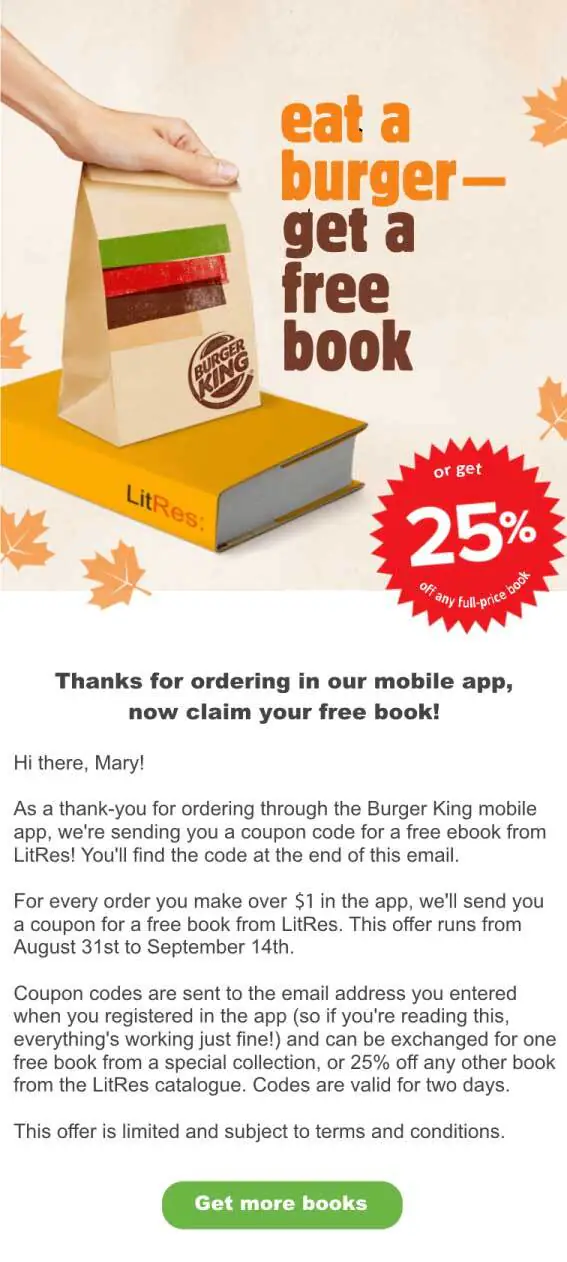
Email with a discount code for customers ordering via the Burger King app
Prior to deploying Mindbox, launching promotions was a complex procedure:
- Marketing created a project description for POS developers to implement.
- POS developers evaluated the project requirements and modified the POS software as necessary.
- The same developers then tested the modified software and installed it on POS terminals in restaurants across the chain.
With this process, it took up to two weeks to implement a single promotion, which was not conducive to the expansion of the chain’s partner program. Burger King needed a fast and simple method of creating promotions that would not slow their POS terminals down.
The solution
In November 2016, Burger King deployed the Mindbox platform, where all promotions are now configured. The integration eliminated any further need to modify POS software. The time required to configure and test a promotion was reduced from two weeks to two hours. Half an hour later, POS terminals and self-service kiosks begin printing promotional codes on receipts.
Now, all the Burger King marketing team needs to set up a joint promotional campaign is Mindbox and a pool of partner codes.
The nightmare is over. With Mindbox, it takes no more than two hours to set up and test a promotion.
Mindbox allowed us to expand our partner network and work with companies like the electronic bookstores and online learning portals.
Faster POS terminals
Before we implemented Mindbox, new promotions with complicated back-end rules often slowed down the POS and led to long ordering lines. When such situations arose, it would take a whole day for technical support to rectify the problem.
When long lines form because of slow POS terminals, business suffers. Money and resources invested in marketing and advertising are lost. When customers come to a restaurant in hopes of getting their promised discount, many will see the line and turn away. Thousands of dissatisfied customers across the country is not a good return on marketing investment.
Even worse, the lagging POS terminals were jeopardizing relations with the target audience of the very promotions that were slowing them down. The average spend of customers who came for the partner code promotions was twice that of regular customers.
Prior to implementing online monitoring, technical problems were identified and addressed manually:
- Cashiers reported errors to technical support.
- The retail director and regional managers visited restaurants to check that promotions were running properly.
Burger King needed a real-time monitoring solution that would keep track of how promotions were working on POS terminals and immediately report any malfunctions.
The solution
Once integrated with the POS system, Mindbox took over the entire process of applying promotions and recalculating menu item prices. Any irregularity in communication between Mindbox and POS terminals is instantly reported via email to Burger King staff, allowing them to quickly and accurately pinpoint the source of the problem — whether this is in the POS terminals, the internal network or in Mindbox itself.
Previously, I would go into our BI system and just see the previous day’s sales without any correlation to footfall data. Now, I can see data on sales volumes linked to POS terminal occupancy rate and footfall. When a problem arises, I can question everyone involved in the process to find out what happened and where. In nine cases out of ten, we find that the problem was down to data synchronization problems on our server and not in the Mindbox CRM system.
UCS now reports fewer problems with receipts not printing and the POS terminals run more smoothly because we reduced the load on them by deploying an external CRM.
Below is a screenshot showing the Mindbox integration dashboard. The left column lists all the processes relating to POS software and promotions, with the next column displaying their status:
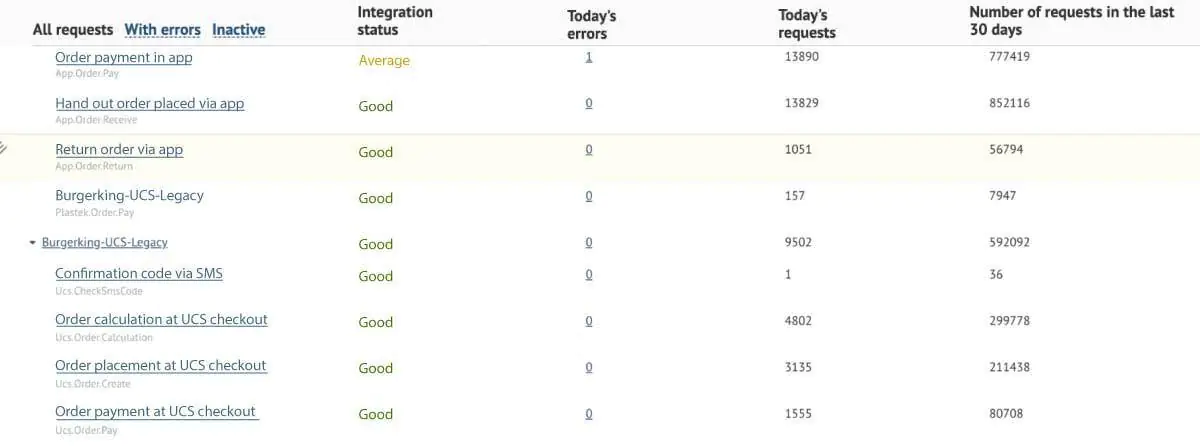
Burger King also introduced its own metric to monitor the time taken from a cashier registering a receipt with a promotional item and its slip being printed. This metric was not to exceed 0.5 seconds.
Automated printing of promotional codes on receipts
Burger King partners with other companies to attract affluent customers whose typical spend is twice the usual average. Customers purchasing a Tank Burger, for example, receive a World of Tanks promo code. Similar promotions were run in conjunction with other brands.
Prior to Mindbox, promo code distribution followed the standard pattern used in most companies. Burger King received a pool of codes from each partner and then printed them on cards or flyers. The printed codes were handed out to cashiers to give to qualifying customers. The process was difficult to monitor and gave rise to instances of staff dishonesty.
The solution
Till receipts are also a medium for communication with customers. Mindbox can generate a personal message that can be displayed to the customer at the POS or tablet screens at cash registers, printed on receipts, sent to their mobile app or delivered via email. These messages can contain any information stored in the system, such as the customer’s name, loyalty points balance and the amount they’ve spent since their first day as a Burger King customer.
This solution was used to eliminate manual handling of bonus codes. Mindbox automatically selects an appropriate code and prints it on the customer’s receipt.
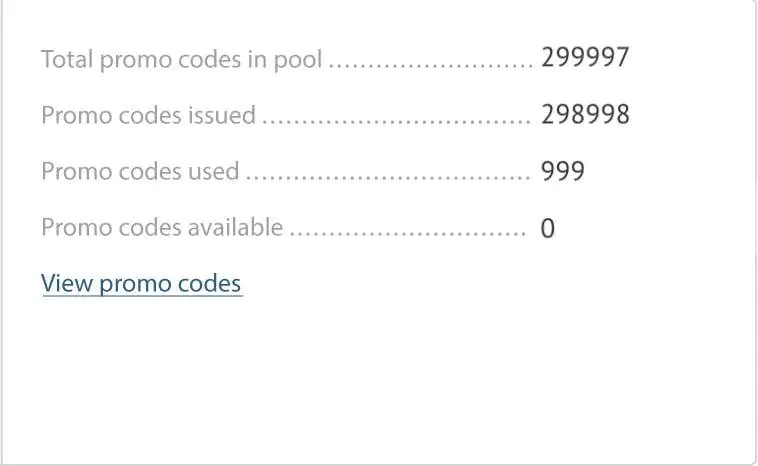
Mindbox lets Burger King track the number of issued and used promo codes and configure alerts when codes are running out
Consolidated customer data from different sources into a unified platform
Burger King stored its customer data in various ERP and CRM systems. With purchases stored in one system and behavior data in another, it was difficult to build a clear portrait of customers.
This setup also led to duplication, where correlated data for one customer was stored in multiple entries in different systems. Duplication gives rise to spam — if the marketing team sends out a bulk campaign to the entire customer database, some will receive two or more copies of the same message.
The solution
At the core of the Mindbox system is the CDP (Customer Data Platform), which can collate fragments of customer information (purchases, behavior, personal data) from different systems. The CDP allows businesses to create a complete portrait of each customer. The resulting data are complete, clean and easy to use.
Burger King uploaded customer data from all its various sources into Mindbox, where they were compiled into a single database of 6 million unique customer profiles.
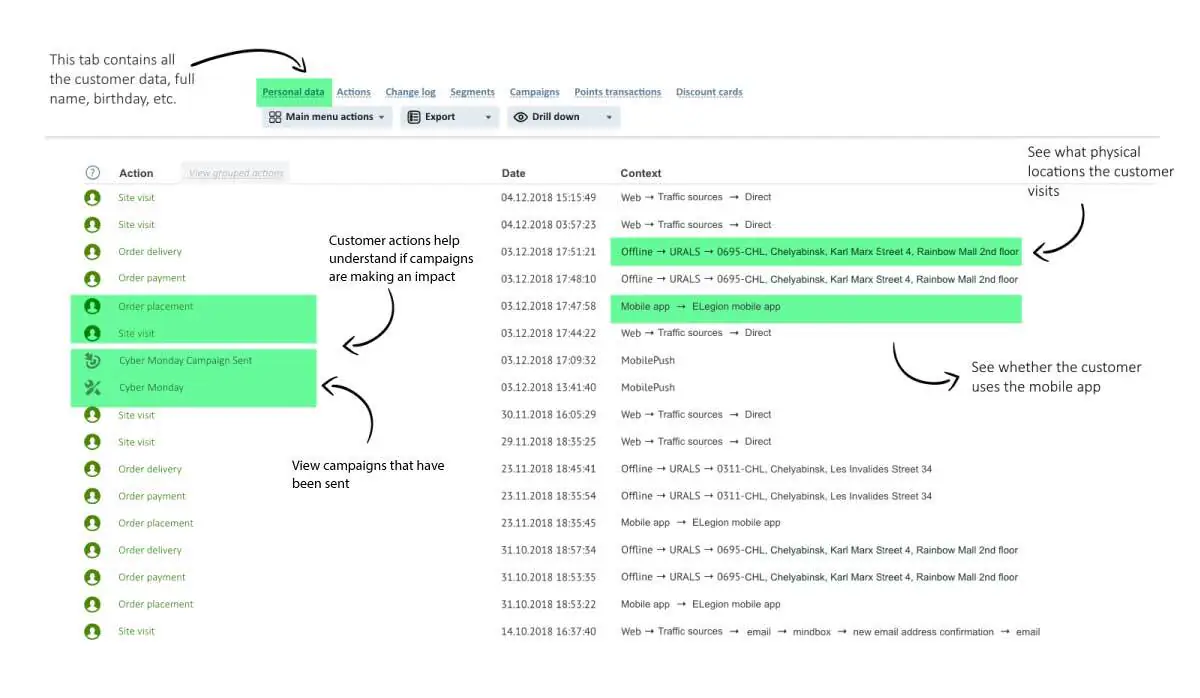
This is what a unified customer profile in Mindbox looks like. Here we can view the customer’s personal data, history of interactions with the company, whether they use the mobile app and which bulk campaigns they receive
With all customer data neatly unified, Burger King can now segment its customer base and only send customers the messages that are relevant to their interests. For example, customers with a total spend between $80 and $160 will receive a discount code for 5% off their next purchase.
With a properly organized and clean database, it’s much easier to identify customers that have not purchased in a long time and take measures to encourage them to return. The marketing team can simply define a segment and configure an automatic campaign to send out gift tokens redeemable for purchases. Regular visitors won’t receive these messages.
We helped develop and launch a pre-order mobile app
The mobile app reduces lines at restaurant counters. Users make their orders via the app in advance (e.g., on their way to the restaurant) and pick them up when they’re ready without waiting in line.
Moreover, the app enables Burger King’s marketing to address the user directly with discounts, promotions and personal offers. It is also a way for users to log into their loyalty program account.
The solution
We started designing the mobile app in May 2017. In September, we announced the launch and released a beta version for testing. In January 2018, we uploaded the first general release to the App Store and Google Play.
The 29th of January is a very special date for us. We had our annual conference in Moscow where all the directors and regional managers get together. It was also Cyber Monday and we were selling Whoppers for 50 cents. We had to stop the promotion two hours after it started because the restaurants ran out of patties. We added a whole lot of new customers to our database that day. Of course, there was the downside that we had to close our doors after just two hours, but it was overall a very positive day for sales with serious growth and a big boost in the number of app users.
Mindbox took on three main aspects of app development:
- UX/UI — we designed the user interface for the pilot version of the app.
- Architecture — how the app interacts with the CRM.
- Business processes — what the app should do and how.
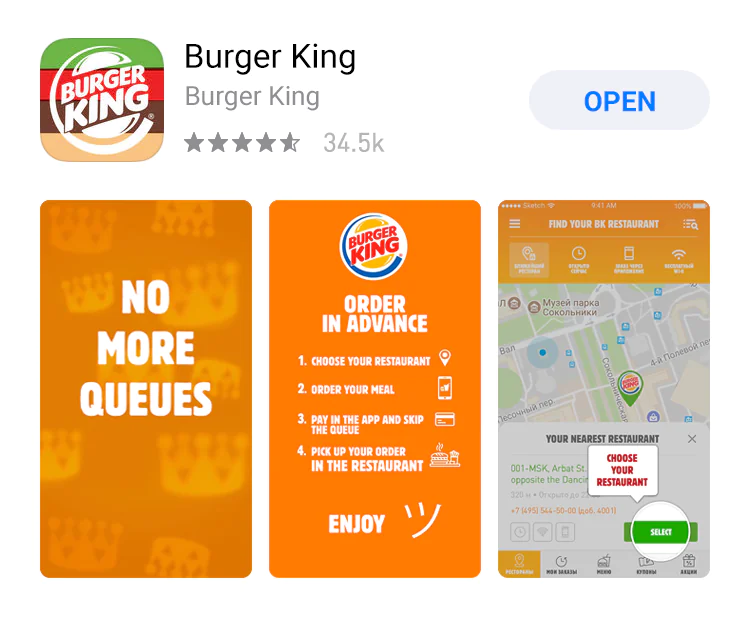
The Burger King app on the App Store
The app currently accounts for 4% of all revenue. Burger King plans to increase this to 7% by the end of 2018.
Loyalty program and personalized communications
The marketing team at Burger King appreciates the importance of not losing contact with customers who have started to use their mobile app, and so they decided to introduce automated and manual email campaigns along with a loyalty program.
The solution
Burger King contacted an email marketing agency to develop their bulk campaign strategy and content. The first bulk campaign was delivered in April 2018.
In addition, we set up some triggers:
- Customers who haven’t made a purchase via the app for a month receive 100 bonus points and an email with an invitation to spend them.
- 20 days after installing the app, if the user hasn’t made a purchase for 10 days, they will receive an email with a discount on a lunch meal.
- 35 days after installing the app, if the user hasn’t made a purchase for 10 days, they will receive an email with a list of all promotions that are currently running.
Trigger campaign results
-
22.4%Average open rate
-
4.15%Average CTR to App Store and Google Play
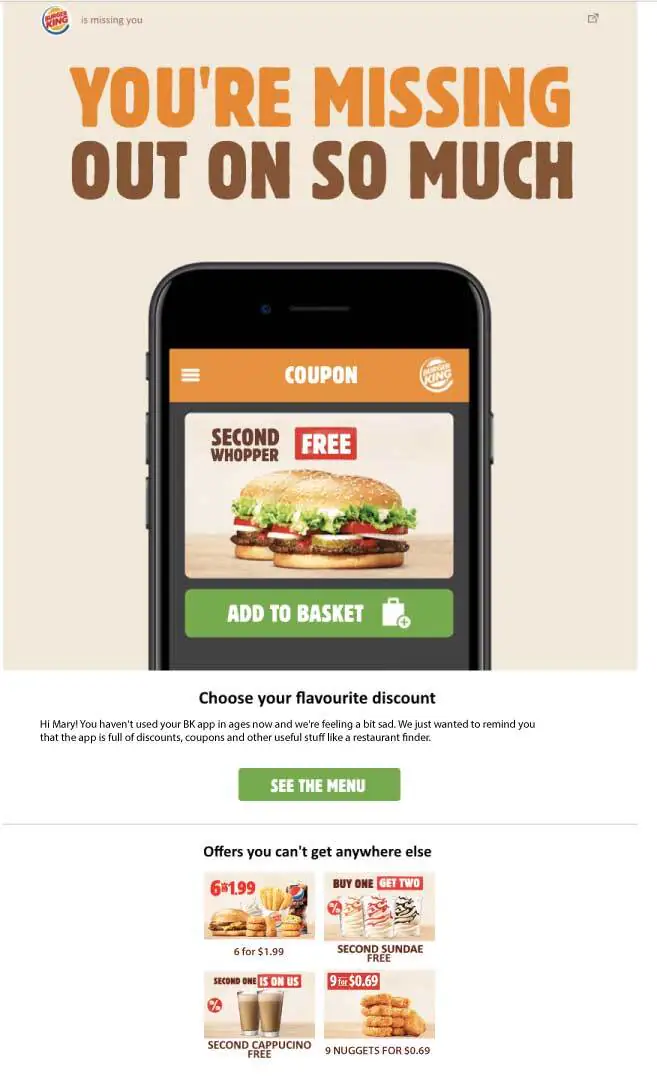
Automated email with a list of all current promotions for users who haven’t ordered via the app for ten days
The loyalty program was launched in September 2018, with promotions and bonus points for purchases and friend invites.
The loyalty system is points-based. So if a user hasn’t logged in to the app for a long time, we will send them an email with bonuses that can be redeemed toward price of a purchase.
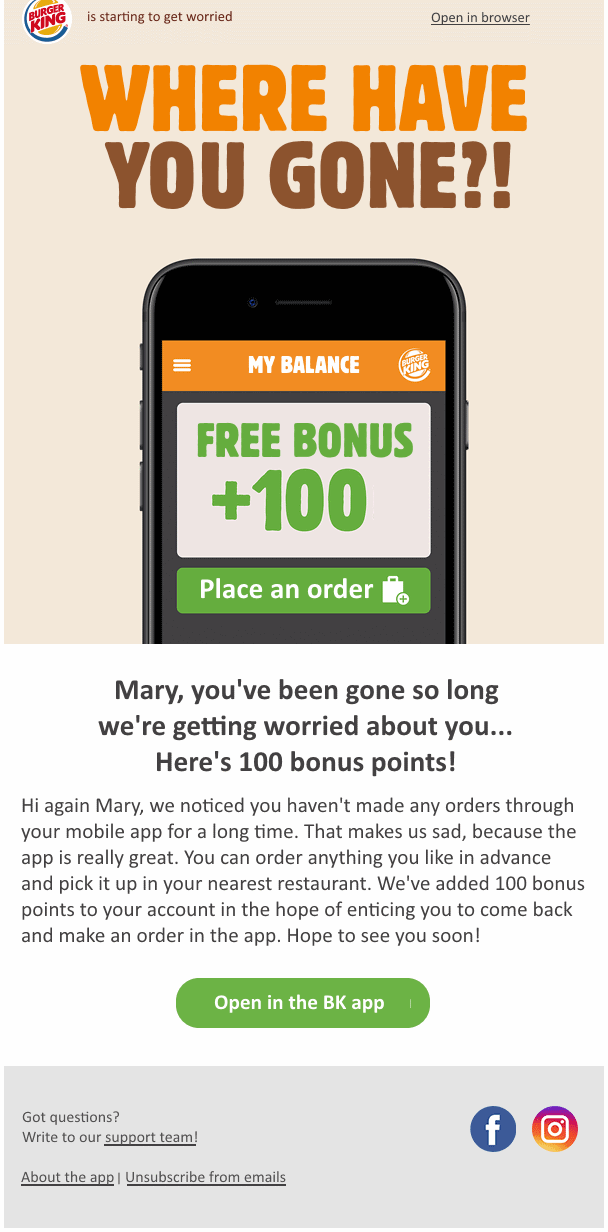
Email for customers who have not made a purchase through the app in a long time, awarding 100 points that can be redeemed when paying for an order
We also set up a referral program wherein users are awarded additional bonus points for inviting friends to use the mobile app.
In October, we set up push notifications with special offers like “Buy a burger and get a free soft drink.”We received the following results from mobile app notifications and bulk email campaigns:
- The mobile app user base has grown to 3.3 million.
- 70% of app users make repeat orders.
Future plans
- Launch bulk campaigns in social networks and messengers.
- Introduce a prepaid system where points can be exchanged in advance for a regular purchase of a particular menu item.
- Let customers pay for a portion of their order at the till using loyalty points via the mobile app.
- Show cashiers personalized promotions to offer to customers.
- Gather information about customers’ favorite menu items and offer discounts on those items at the till.
Promotions were launched in the timeframes I had planned for them and proved to be profitable. In several, situations my expectations were exceeded because I previously had no idea that there were ways to reduce the number of problems, and how to identify and solve those problems.
Now, I just send out a pool of bonus codes and ask for them to be entered into the system. I get an immediate reply telling me everything will be good to go within two hours.
What I don’t like: I don’t like that I still have to think. Ideally, I wouldn’t have to do that and someone would do all the thinking for me, then write and tell me that they’ve taken care of everything. 🙂
What I do like: I’m getting a better understanding of how the system works. I’m not an IT guy — my job is marketing. All the complicated stuff was explained in simple terms — how promotions work, how sequences work, how things should be set up. What I like most is that I get asked for clarifications — “We’re launching this promotion now, do you want this bit to be like this or like that? Do you want to use this approach or another approach?” There are lots of projects and not enough time to think through all the minutiae. I don’t always have enough experience to refer to, so it’s very important to me that we have experts who know exactly what they’re doing and can advise how to set things up best.
I’m really pleased with the Mindbox integration and system architecture. I only started getting into it deeper this year when we really began working with it in earnest, and saw how various things are set up and configured. I’d say there’s room for improvement but I can understand how everything works.
I definitely wouldn’t recommend it to KFC or McDonald’s. 🙂 Mindbox is a “terrible system, ” “nothing ever works” and “it’s nothing but trouble.” 🙂
Our next major goal is to engage with our clients on social networks. We’ll be focusing much more on online activities.
In summary
Burger King tasked Mindbox with improving the procedure of enabling and running promotions on POS terminals. Promotions previously had to be enabled by the POS terminal software developers, a process which took from 1-2 weeks. The POS terminals were struggling to do three things at once — take orders, apply promotional modifications to the order and print receipts.
Now promotions are now configured in Mindbox. We take care of:
- Enabling and running promotions in all regional Burger King restaurants and in the mobile app. Promotions can now be set up in two hours instead of two weeks.
- Printing partner bonus codes on receipts. Bonus codes are automatically printed on receipts when an order contains a promotional menu item, and POS terminals no longer freeze up.
- Monitoring POS terminal statuses in all regional restaurants. The Mindbox admin console displays the health status of POS terminals and promotions in all restaurants across the country. If a malfunction occurs, our system immediately sends an alert.
With the problem of POS terminals and promotions solved, we set about doing a whole lot more:
- Cleansed the Burger King customer database.
- Helped design their mobile app.
- Used the cleansed database to launch campaigns promoting the mobile app.
- Integrated the loyalty program with the mobile app, featuring coupons, promotions, bonus points for purchases and inviting friends.
Today, the Burger King mobile app has more than 3.3 million users, 70% of whom make repeat purchases.



